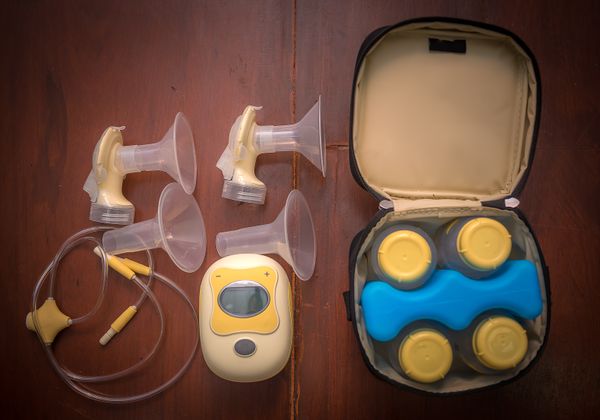By Linda C. McGrath, PhD, CHES, IBCLC, LLLL, and Vincent R. McGrath, EdD
What if scientists created a product that would protect infants from developing chronic illnesses such as asthma, diabetes, obesity, respiratory infections and ear infections? What if this product could protect infants from developing allergies? What if this same product would also protect mothers from developing breast, ovarian and other types of cancers?
What if this product could be used without any of our energy resources and could be used at all times, even in times of natural disasters? What if several billion health care dollars could be saved by using this product? What if nature creates a product that encompasses these qualities?
She has, and this product is a mother's milk.
Healthy People
Healthy People is a federal initiative updated every 10 years since 1989 by the Department of Health and Human Services in cooperation with health care agencies to improve the quality of our nation's health by producing a framework for public health prevention priorities and actions. Breastfeeding objectives are critical parts of Healthy People to improve maternal and child health. These objectives are: 75 percent of mothers breastfeeding at the time of hospital discharge, 50 percent breastfeeding at six months and 25 percent at the end of the first year.
Healthy People 2020 aims to increase these rates to 81.9 percent initiating breastfeeding, 60.6 percent breastfeeding at six months and 34.1 percent continuing at one year.
If these objectives were realized, there would be more than $4 billion saved in health care costs. Families would experience lower medical costs as a result of fewer incidences of chronic illnesses in their children. Respiratory and ear infections would seldom occur in infants.
With fewer visits to doctors, working mothers would have fewer days and hours absent from work. Mothers would lower their risks of developing breast cancer and other types of cancers. Healthy physical and emotional development in both mothers and infants would occur.
Infant Nutrition
A mother's milk has every vitamin, mineral and other nutritional element that her baby's body needs, including many that haven't been discovered or named yet, and it changes subtly through the meal, day and year, to match subtle changes in her baby's requirements.
The components in breast milk are easily absorbed and utilized by the baby for normal growth and development. At no other time in life can a complete source of nourishment be contained in one food source as it is in breast milk. Breast milk is easily digested; therefore, it does not add stress to a baby's internal systems, which still need months of growth and development.
The growth hormones, which are necessary and can only be found in breast milk, encourage and enhance a strong development in the baby's organs, especially with the brain. All the types of nutrients that are needed to complement the human brain can only be found in breast milk.
Infant Health
The first milk is colostrum. It contains high amounts of immunoglobulins to compensate for the baby's immature immune system. Colostrum should be recognized as the baby's first vaccine. If a mother gets sick, her body will naturally produce antibodies to fight the infection. These antibodies are then transferred through the breast milk to her baby, who will either not get sick or will have a milder case of the illness. If the baby gets ill, the mother's body will produce antibodies for the illness and transfer the antibodies through her milk. The baby will recover faster, and continued breastfeeding can help prevent dehydration in the baby.
Employed mothers who breastfeed report fewer work days missed and fewer doctor visits with sick babies. Breastfed babies seldom get constipated or have diarrhea, ear infections or respiratory illnesses, because breast milk has all the right components in just the right amounts for infant growth and development. Breastfeeding has now been associated with lower risks of both type 1 and type 2 diabetes and sudden infant death syndrome (SIDS).
Maternal Health
Mothers who breastfeed have a lower risk of breast, uterine and cervical cancers. Most mothers with diabetes who breastfed have required less insulin.
Because lactation is the next stage of female development after pregnancy and childbirth, mothers who breastfeed experience less bleeding, a return to the prenatal body shape and some weight-loss more naturally. With the first six months of exclusive breastfeeding, the return of fertility can be delayed which allows the mother's body time to heal before another child is conceived.
Breastfeeding, Obesity and Other Metabolic Conditions
Studies describe the link between infant feeding practices and obesity later in life. Research reports that the risk factors for obesity include bottle-feeding, a maternal body mass index (BMI) above 27 and maternal smoking during pregnancy.
Regulating Feeding
The baby is in control of the amount of milk taken at each feeding. The feeling of satiety (fullness) is developed and learned, which is so necessary for future weight gain. With bottle feeding, the caretaker is in control and usually ensures that the amount in the bottle is taken. This is the beginning of force feeding and can interfere with the natural development of satiety in the baby.
The hormone leptin regulates appetite and is found in higher concentration in breastfed babies. It is now being researched as a preventive component for obesity. Research documents that children who were breastfed, as recommended by the American Academy of Pediatrics, have a lower risk of developing excess weight or obesity.
The high amounts of immunological components in breast milk enhance the maturation of the infant immune system. At birth, the infant depends on passive immunity through breast milk for protection. The transfer of antibodies through breastfeeding stimulates response in the infant's immune system.
At no other time in life can one food source offer total nourishment and protection from pathogens, support emotional needs and complement total growth and development. These positive effects with breastfeeding are dose-dependent, and the introduction of breast milk substitutes in the first six months of life is associated with a higher risk of ill health and premature weaning.
Conclusion
Yes, if the United States becomes a society that encourages, supports and protects breastfeeding as the appropriate infant feeding practice, infants would receive the healthiest start in life and their birthright—mother's milk. Human nurturing—a unique lifetime bonding that exists between a breastfeeding mother and her child—would be encouraged, supported and protected by all professionals and agencies serving families. Images of a baby at the breasts would be acceptable and natural, and the plastic bottle would be replaced as the icon for infant care.
Exclusive breastfeeding for six months, with extended breastfeeding beyond the first year, is recognized as the appropriate infant feeding practice by the American Academy of Pediatrics and other major health care academies, and is listed as a critical strategy in reversing this trend of chronic ill health in children.
For more information on Healthy People 2020, visit www.healthypeople.gov. To locate health care providers and knowledgeable breastfeeding support personnel that can offer assistance and answer questions about breastfeeding, visit the United States Breastfeeding Committee. For information about the most recent data on breastfeeding rates in the United States, visit www.cdc.gov/breastfeeding.
About the authors: Linda C. McGrath, PhD, CHES, IBCLC, LLLL, is a Certified Health Education Specialist (CHES), Lactation Consultant (IBCLC) and a La Leche League Leader (LLLL) from Starkville, Miss.
Vincent R. McGrath, EdD, is a Professor Emeritus for the College of Education at Mississippi State University.
"Breastfeeding: The Infant Feeding Practice" originally appeared in the summer 2011 issue of Your Weight Matters Magazine, a quarterly magazine published by the Obesity Action Coalition (OAC). For more information on the OAC, please visit www.ObesityAction.org.
References:
Beilin L and Huang RC. Childhood obesity, hypertension, the metabolic syndrome and adult cardiovascular disease.
Clin Exp Pharmacol Physiol. 2008;35(4):409-411.
Hanson LA. Immunobiology of Human Milk: How Breastfeeding Protects Babies. 2004.
Saenz RB. Affordable healthcare begins with breastfeeding. Presented at the Mississippi Department of Health statewide meeting for insurance providers, April 29, 2009, in Jackson, MS.
Wiessinger D, West D, and Pitman T. The Womanly Art of Breastfeeding, 8th ed. 2010.







